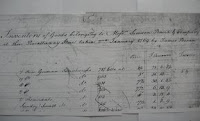 As an artist I work alone creating my paintings in my studio, and when the work hangs in a gallery all eyes are on me. People ask me questions about technique, color, titles, education, and influences. While my work receives attention and I receive praise, there is a silent web of people that stand behind me that are always in the background of each success, each show, and each opportunity.
As an artist I work alone creating my paintings in my studio, and when the work hangs in a gallery all eyes are on me. People ask me questions about technique, color, titles, education, and influences. While my work receives attention and I receive praise, there is a silent web of people that stand behind me that are always in the background of each success, each show, and each opportunity.
Today's blog is a thank you to all the members of my team. I definitely stand on the shoulders of giants, and I am grateful.
My wonderful and patient husband never blinked when I said "okay- I am quitting my day job and focusing on art." He lets me dream big and then act crazy and difficult when obstacles to my dreams come up...He has been my web designer, brochure printer, photographer, driver, art transporter, art packer, proofreader, and a fixture at art openings. He believes in me and my art, and he deals with me when I face all the ups and downs that come with being an artist. He helps me seize every opportunity that comes my way.
My entire family is incredibly supportive of me and my art. I am lucky that my family supports me in this way. They have never questioned my reasons for being an artist. They give me feedback when I ask for it, and praise. They acknowledge that this can be a crazy and hard business, but that I have the skills to make it. They are freely giving of their time and particular skills if they think can help me. Some of the services my family has provided: materials, financial support, proof-reading, editing, a sounding board for ideas, legal aid, critiques, connections, enthusiasm and interest in my work.
Teachers over the years have always focused on my creative side and made me feel smart even if I was almost failing math. I am not talking just about art teachers, I am talking about any teacher that I have ever come into contact with that pushed me and stood behind me and encouraged me to go for it. I am especially grateful to my mentor Ron Graff at the
There are many artists that I have worked with and have known over the years that have helped me tremendously. While still in school, one classmate bought a small piece of my art that was a part my BFA exhibit, before I even thought about selling my art; I was just in love with making it. When she tracked me down at my apartment and wrote out a check for $50.00, I had goose bumps. I felt like I had just won the lottery - this small thing was so monumental. There is another artist, Wendeline Matson who helped me get my foot in the door at the Blue Moon gallery and for that I will always be thankful. Sometimes, that is all it takes and can change things dramatically for years to come.The Blue Moon was the first gallery to represent me on an ongoing basis.
Gallery owners who have represented me have taught me so much, and they have stuck by me through thick and thin. They have helped me believe in myself, and have gotten my art out to people who may never have seen it otherwise. I have been lucky to work with such professionals who really are invested in art and the artists they represent.
There are so many friends over the years that have helped, supported, and purchased my art. There are friends that have helped me to celebrate my milestones, as well as friends who push me to push myself harder, when I am sliding. I don't tell them enough how lucky I am to have them in my life.
Since this post can't last forever, I will just have to summarize but this is dedicated to all the people who have talked about my art with their friends, published my art, written about my art, bought my art, offered me opportunities to show my work, took time to advise me, and have been generally supportive of me. You are my heroes. I could not do what I do without all your help, love, and support. So, thank you, I am truly grateful.
I realize that I am fortunate to have all this support and that some artists do not. I hope that this post might encourage artists out there to start counting all the forms of support that they do have in their lives, most of the time we are so busy we don't see what is right in front of us. If you still feel you lack support and encouragement, I want to give you a little. Being an artist is an important, meaningful, and valid path to take in life. We need your art in the world, and only you can make your art. I hope success, happiness, and many opportunities come your way, you deserve it.


